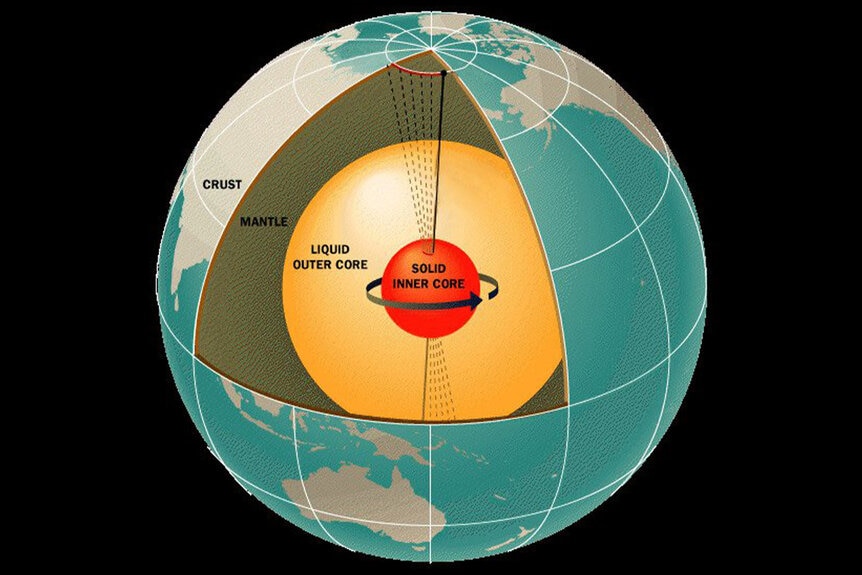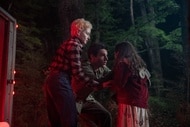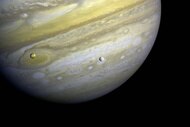The Rotation of the Earth's Core Is Slowing Down: So What Does That Mean?
It sounds a lot worse than it is.

The 2005 natural disaster flick Descent (streaming now on Peacock) stars Beverly Hills, 90210’s Luke Perry and Star Trek’s Michael Dorn as Dr. Jake Rollins and General Fielding, two members of the cracker jack team hoping to save the planet from total destruction. The Circum-Pacific belt, popularly known as the Ring of Fire, is a trail of disaster roughly 25,000 miles long, surrounding the Pacific Ocean. It runs up the eastern coasts of Australia and Asia before cutting across the arctic and down along the western edge of North and South America.
The Ring of Fire contains roughly two thirds of the world’s volcanoes and is responsible for about 90% of the world’s earthquakes. In Descent, the Ring of Fire starts acting up, filling the world with natural disasters and threatening the continued existence of our species. The whole thing was sparked by a temper tantrum in the Earth’s core, and a team of scientists embark on a subterranean adventure to fix the core and save the world.
Now, scientists in the real world have identified some unusual behavior in the Earth's core. As far as we can tell, it won’t threaten our survival, but it could make the days just a little bit longer and help scientists understand what’s going on in the heart of our planet.
For More on the Earth’s Core:
Did the Earth's Core Really Stop Spinning or Reverse Direction?
Earth's Solid Inner Core May be a Little Bit Mushy
New Study Suggests the Earth's Inner Core Might Have its Own Innermost Core
The Earth’s Core Is Slowing Down, but It’s Probably Nothing to Worry About
From our comfortable position on the planet’s surface, the Earth looks like a fairly static place. The ground beneath your feet stays there for the most part, but the planet is alive beneath the surface. If you started to drill straight down, you’d keep finding crust for between 3 and 45 miles. Next, you’d find the mantle, the largest layer of our planet, extending another 1,900 miles. The outer core is nearly as big, going roughly 1,350 miles deeper before reaching the solid inner core.
The inner core is a solid sphere of metal, mostly iron and nickel, surrounded by the hot, molten outer core. Its rate of rotation depends on a lot of things, including interactions with the overlying layers, and it differs from the rotation of the planet as a whole. From the outside, you would see the core and the rest of the planet spinning in the same direction at different speeds, but from our POV on the planet, it sometimes looks like the core starts spinning the wrong way.
A new study published in the journal Nature looked at more than a hundred earthquakes from the same spot in the South Sandwich Islands between 1991 and 2003. Researchers were looking specifically for waves which penetrated the inner core, capturing information about its status along the way. They found waveforms which changed and then reverted back to their earlier state. Those matching waveforms reveal times that the core was in the same position relative to the mantle. In other words, they could measure the rate of rotation by measuring the interval between matching waveforms.
They found that it was super rotating between 2003 and 2008 before getting two to three times slower between 2008 and 2023. Much like how the rest of the planet impacts the core, the core also impacts the rest of the planet. If it keeps slowing down, its influence could slow the rotation of the rest of the planet, lengthening the day. However, it would be such a small change over such a long period that we wouldn’t really notice it. Moreover, the effects could be temporary, and the core could speed up again at any time.
Because we only have detailed data going back a few decades, it’s difficult to know if this sort of slowing is a common behavior or something out of the ordinary. We’re really at the beginning of core science and observations like these provide the baseline data around which future observations and models will be built. It’s interesting science, but it’s not the sort of thing we need to call Michael Dorn about.
Save the Earth’s core in Descent, streaming now on Peacock.





























